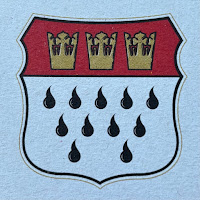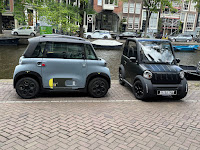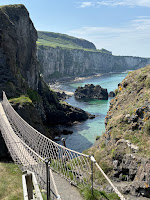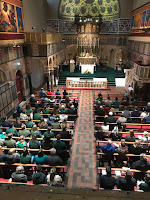Börsenplatz, Köln (Cologne), Germany
You would've expected this memorial to be in a place of prominence for the city of Cologne; instead, it is a few kilometers away from the heart of the city (Cathedral Square), assigned to a humble street where the tourist buses unload their passengers.
What I speak of is the memorial to Sister Teresa Benedicta of the Cross, otherwise known as St. Edith Stein.
First about the cathedral. The mighty Cathedral of St. Peter was started in the middle of the thirteenth century (Approximately 500 years before things started to get interesting in the soon-to-be United States). The completion of the project took place in the 1880's, only to be nearly undone in the 1940's by World War II. More than a dozen bombs fell on the church, but somehow the walls remained intact. (The Allies had quite the pragmatic reason for leaving the cathedral intact: it was a massive marker for the rest of this industrial city).
All major cities in Europe have their crests; Köln (Cologne) has an insignia with twofold significance. The upper portion has three crowns, a reference to the Reliquary of the Three Magi enshrined in the cathedral. The lower portion has eleven tears, indicating the fabled thousands of virgins and St. Ursula who were murdered by Attila the Hun (and by this sacrifice claiming the city for Catholicism). It's a fantastic story, and regardless of its veracity assured the footprint of the faith – the Cathedral of Saint Peter stands in witness to this.
But as I said, a few kilometers away, standing only about six feet tall (as opposed to the 515 feet of the Cathedral) is this striking monument.Created by Bert Gerresheim in the 1990's, it shows the evolution of Edith Stein from a young Jewish woman to a divided soul searching for truth, and finally, to a Carmelite nun carrying forward the crucifix of her dying Savior. These three figures are clearly on a journey, which is represented at the other end of the statue's platform. What appears there is both appalling and immediately recognizable as the piles and piles of empty shoes – sole evidence of what took place in the gas chambers built by the Nazis.
Edith Stein was drawn deeply into the Catholic faith after reading the works of the woman she chose to name herself after: Teresa of Ávila. After joining the Carmelites, the order sent her to the Netherlands to escape the grasp of the Nazis, but this proved to be futile, for in 1942 all baptized Catholics of Jewish origin were arrested and eventually transported to Auschwitz.Sr. Teresa was given an opportunity to escape before the Gestapo got their hands on her. But she refused. She died in the gas chambers of Birkenau in early August, 1942.
I ponder the immensity of this woman's witness, her refusal to abandon the road that would lead to her martyrdom, and the fact that this memorial to her bravery sits, almost ignored, near a bus depot. Our world is filled with both atrocities and absurdities, especially when it relegates its heroines to a place that would seem to be an afterthought.





































